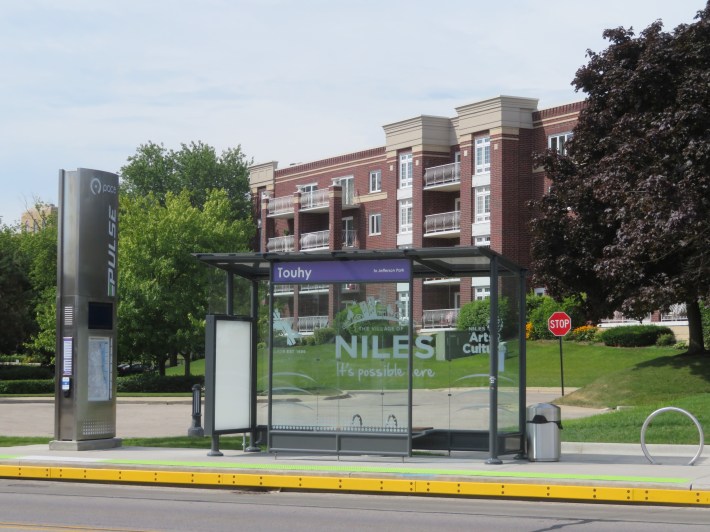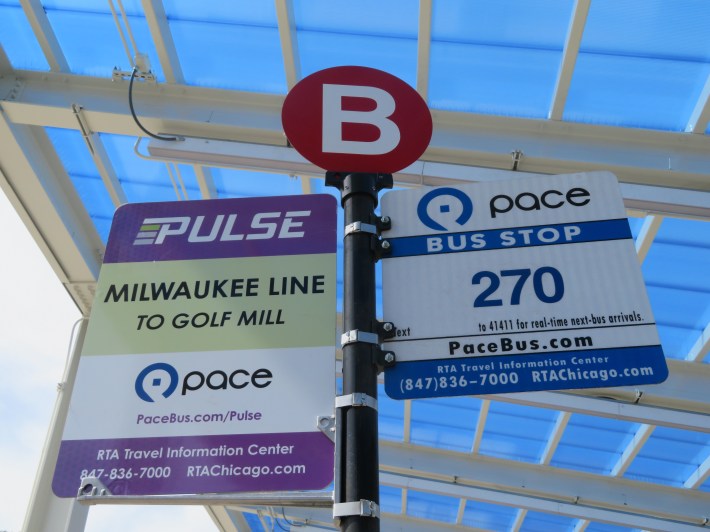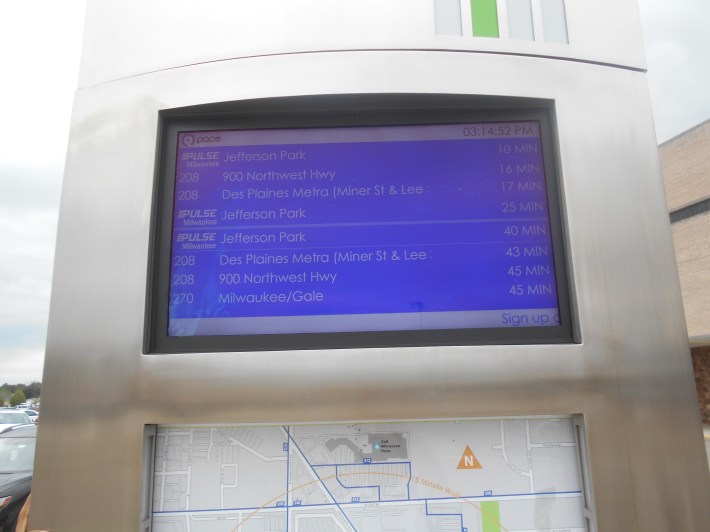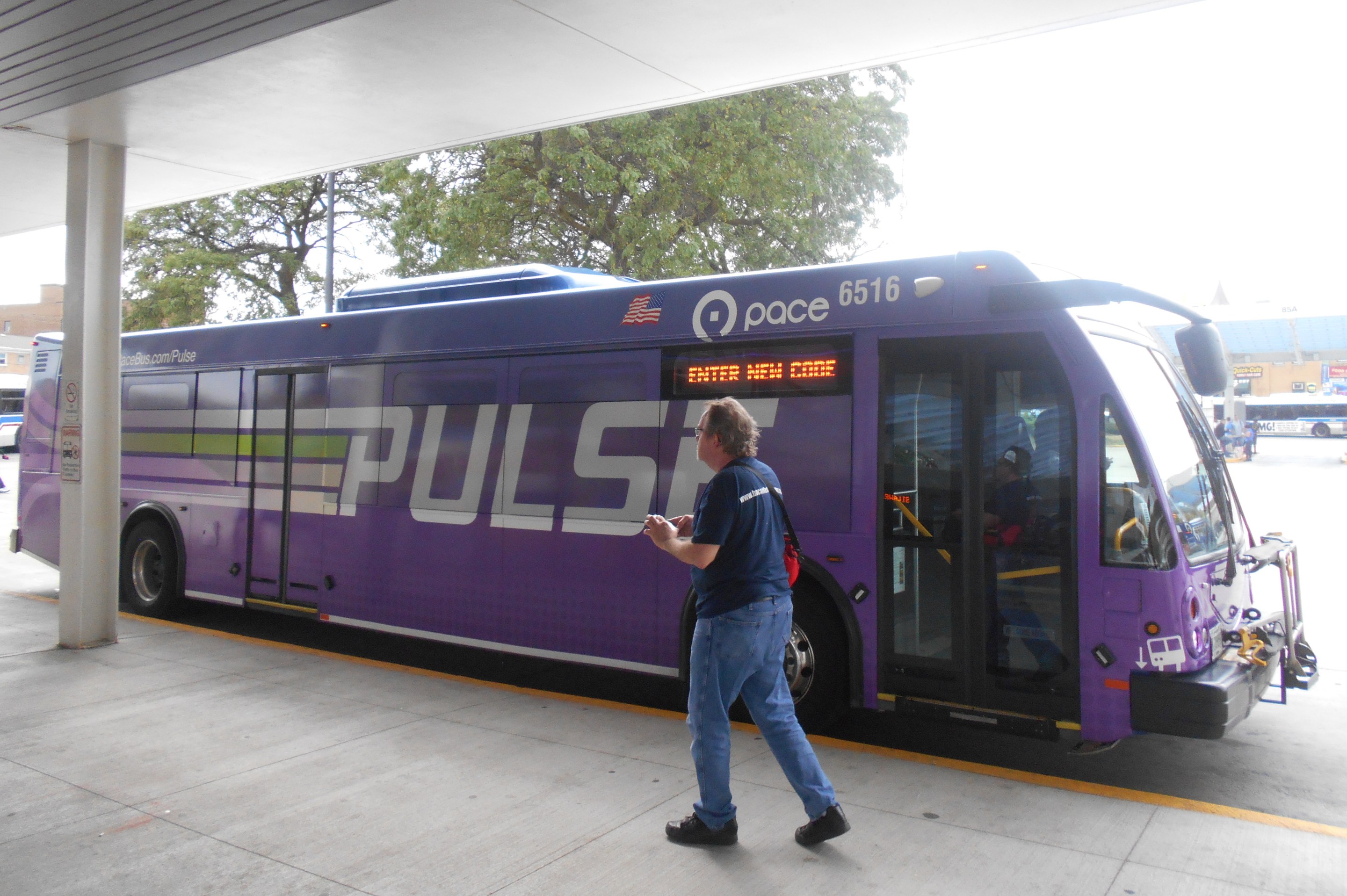Pace's new Pulse Milwaukee Line express bus route didn't get off to a completely smooth start, but it's still a promising improvement to suburban transit.
I checked out the route on Sunday, the first day of the express service, which features stops no closer than a half mile apart. There was the inevitable confusion as riders tried to understand the ins and outs of the new system, especially since the local Route 270 bus is still serving the same corridor, albeit on a significantly reduced schedule. But there were also some glitches with the buses' destination signage, and occasional snafus with the real-time arrival notifications, that didn't make things any clearer.

That said, the new buses are indeed faster than the regular Route 270 service, especially in light traffic. Many of the features did work as advertised -- the raised platforms at the stations really did make boarding easier, and the video screens inside the buses gave fairly straightforward route info. I didn't have a chance to observe the transit signal priority aspect of the service, which got its first big test today as the Pulse buses made their way through rush hour traffic.
Pace has been working on the Pulse program, for the last decade, with the goal of speeding up some of its busiest corridors. Route 270, which primarily runs along Milwaukee Avenue, linking the Jefferson Park Transit Center, Golf Mill Shopping Center, and Glenbrook Hospital, certainly qualifies.
Pace originally acknowledged that Pulse wouldn't be full-fledged Bus Rapid Transit (although the press release for yesterday's launch called it that) because it wouldn't feature car-free bus lanes. Initially the transit agency talked about potentially incorporating about a few bypass lanes at certain spots, but that idea was dropped fairly early on.

While in the long run, Pace hopes to add express service along its entire Milwaukee route, the current Pulse Milwaukee Line only runs as far as the shopping center. The transit agency is keeping Route 270 running to provide first- and last-mile connections on Jefferson Park-Golf Mill segment and to continue serving Milwaukee further north, but the local buses now only run about once an hour. That cut helps allow for more frequent and later service for riders traveling to major destinations along the Pulse portion of Milwaukee. The service operates on weekdays between 5 a.m. and midnight with 10-minute frequency during rush hours, 15-minute frequency during non-peak hours until 10 p.m., and every 20 minutes from 10 p.m. until midnight.
The Pulse buses are wrapped in purple to advertise the service, and they offer free Wi-Fi (the transit agency has been quietly phasing Wi-Fi in on all of its buses) and USB chargers located under the seats. Pro tip: If you're on a Pace bus and see multiple Pace Wi-Fi networks available, log on to the one with the same digits as the vehicle's serial number, displayed in big white numbers above the bus' front window.
Back in July 25, I attended a special sneak preview of the Pulse Milwaukee Line. At the time, Pace was still working on the Niles bus stops, and spokesperson Maggie Daly Skogsbakken said that the stops in Chicago wouldn't be ready by the public launch date. She added that, at the recently renovated Jefferson Park Transit Center, the Pulse buses would stop at the same bay as Route 270 vehicles. While Pace talked to the CTA about doing something more station-like for the Pulse buses at Jeff Park, the CTA vetoed that idea.
So what's it like riding Pulse? Let's start with the positives. As someone who's ridden Route 270 many times while reporting in Niles, I can tell you that the Pulse buses definitely feel faster, especially when the traffic is light. Even in heavier traffic, the less-frequent stops buses save you a few minutes.
In terms of keeping up with its standard 15-minute non-peak headway schedule, the arrival times of buses weren't especially predictable -- sometimes there were more than 15 minutes between runs, other times less. That might have been partly due to some extra congestion caused by the CTA shuttling riders between Jefferson Park and the Harlem 'L' station to accommodate construction for a $207 million signal upgrade project.
The video screens on the buses show more than just general information about the service. Once every minute or two, the they show the map of the previous stop the bus was (Pace somewhat refers to the fancy bus shelters as "stations" but Streetsblog Chicago does not use that term for bus stops that lack prepaid boarding) at and all the stops it has yet to reach. It's a pretty useful visual aid that's unlike anything I've seen in Chicagoland transit.

Some of the Pulse bus stops, especially within Chicago, still aren't finished – for example, the northbound Touhy stop's shelter was missing panels. But the real-time arrival information displayed on the giant stainless-steel bus stop kiosks worked as promised, showing not only info for Pulse buses, but for other buses that use the stops. There's even an option where you can press a button and an automated voice system will read out the information for you, useful for riders with visual impairments. The one issue I found with that is that the voice refers to the Pulse Milwaukee Line as “Route 100," which could be confusing for the uninitiated.
There were a few other hiccups. For the past few years, Route 270 has operated as a posted-stop-only route, rather than allowing riders to get on and off buses where they please by flagging down the bus or asking the driver to let them off. But Many riders were still confused why the Pulse buses were only picking up and dropping off passengers at Pulse stops. There's bound to be a learning curve, as there was with the posted-stop-only policy, and riders will adjust in time. But I did notice several riders who seemed to speak limited English struggling to understand why the Pulse buses weren't stopping at all the Route 270 stops.

As someone who immigrated to this country without knowing much English myself, the question I always ask when covering transit changes is how much outreach there is to people who people who aren't fluent speakers. In the case of the Pulse Milwaukee Line the service area has sizable Latino, Polish and Korean populations. Fliers in explaining the new service in Spanish, Polish and Korean would have gone a long way towards reducing the confusion.
And there's also clearly a learning curve for the bus drivers. There are several intersections that have both Pulse stops and regular bus shelters. Daly Skogsbakken previously said that in Niles the regular bus stops near the new shelters will be removed. Pace fliers went out of their way to explain that, as of Aug. 11, all buses will stop at Pulse stops in Niles and at regular bus stops in Chicago. But I saw several instances where, when approaching the corner of Touhy and Milwaukee avenues, drivers stopped at the older bus shelter closer to the intersection rather than at the new Pulse stop.
The bus signage was another rough spot. Throughout yesterday afternoon, I saw several instances when the Pulse buses' destination displays read “Route 270” or error messages. The drivers I spoke to said there was some kind of system-wide issue, and they couldn't do anything about that. Hopefully, whatever the problem was got resolved by today.
Still, the Pulse Milwaukee Line service worked pretty well overall, and once those speed bumps are addressed it will be a nice amenity for Northwest Side straphangers.






